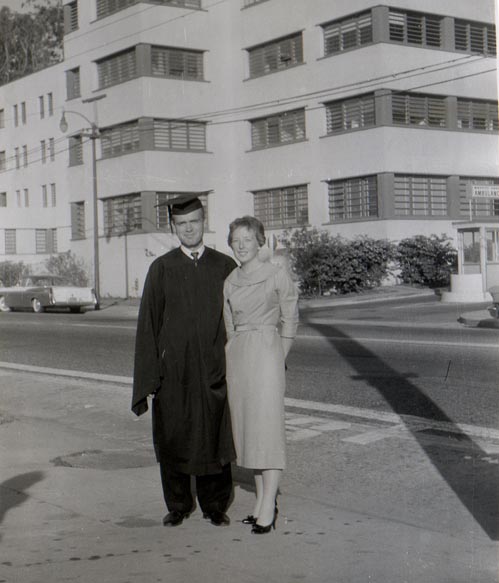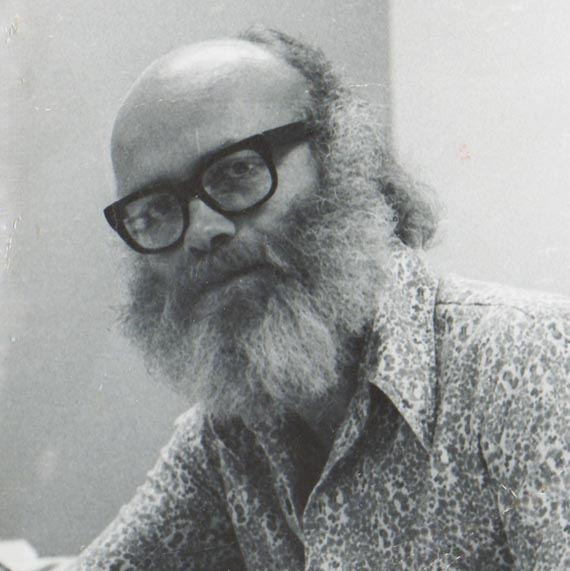Bob Day: An Oral History
When Robert (Bob) Day retired from UCSF in 2012, his legacy could be measured not only in the number of years of service, students taught, and jokes cracked but also in pounds, volume, and linear feet. Readers of this blog know from recent posts that Bob Day was an inveterate collector of material related to the history of pharmacy in general and the UCSF School of Pharmacy in particular, and the material he accumulated over his 50 years with the university was donated to the UCSF Library’s Archives and Special Collections. The materials processed by archivists totaled 40 linear feet, over 45 boxes, and an untold number of individual items. You might be asking yourself, what does all of this material tell us? What is its significance? And what kind of person would be compelled to collect all of these items?
All of those questions were asked – and many of them answered – in a long, detailed, interesting, and rollicking oral history interview I conducted with Bob in the first three months of 2013. In partnership with the UCSF School of Pharmacy and the UCSF Library’s Archives and Special Collections, the Regional Oral History Office of the Bancroft Library at UC Berkeley planned and conducted this interview. In all, a little over 12 hours of interviews were committed to videotape, which were then transcribed, edited, and, now, made available to you here: http://digitalassets.lib.berkeley.edu/roho/ucb/text/day_bob_public.pdf.
What transpired in those dozen hours?
Well, the transcript contains nothing less than a broad, well-conceived history of pharmacy over the course of the twentieth century. Bob offers insights into the early history of the UCSF School of Pharmacy, drawing on the documents he collected over the years. He discusses the transformation of pharmacy education, including the emergence of PharmD degree in the 1950s—in the process answering why the degree was needed then and thus why it took hold as a professional standard. Some of the most interesting, and important, exchanges addressed the famed “Ninth Floor Project” at UCSF and the birth of clinical pharmacy practice in the United States; Bob’s account is brought alive through his well-drawn portraits of the many young Turks who ventured into the unknown and quite literally changed pharmacy as a result. The overall arc of history portrayed in this interview clearly shows the transformation of a profession from one that sold goods to one that offered services, from one that was stymied by other medical professionals to one that would make important and necessary contributions to medicine, from one that was “product-focused” to one that became firmly “patient-focused” (thanks to Dean Guglielmo for offering up that last formulation). With this interview, we not only have an outline of the history of pharmacy in the twentieth century, we have a pretty good first draft of it too.
Along with the detailed institutional story and the history of the profession, the interview offers great insight into the question, what kind of person would collect so much material about the history of pharmacy? Bob reveals a bit about his upbringing in Sacramento and his brief flirtation with enrolling in Catholic seminary school. He discusses his interest in chemistry but also a frustrating incident at UC Berkeley which sent him in a previously unforeseen direction: pharmacy school. A spirit of generosity is laid bare when he discusses the Ninth Floor Project—always giving credit to his colleagues and usually decentering his own role in the process: rarely have I conducted an interview in which the names of colleagues appear so regularly and with such appreciation. Bob’s ability to change comes forth in the interview as well. Not only is he ready to move with (and himself push) changes in the profession, but he tells how the events of the 1960s, particularly the Kent State shootings, profoundly affected him and thus sent him in a different direction personally: gone were suits and ties, new were jeans, a long beard, and a sense of connection with what was happening down the street in the Haight-Ashbury. The connections between his own life and the changes happening in the profession of pharmacy are readily apparent in the transcript, but I’ll hold off on pointing them out here for that might ruin some of the pleasure in reading this remarkable story, told so well.
The two-hundred and thirty seven pages of this interview transcript offer much more too, more than even can be alluded to in this short blog. I encourage you to read the transcript, and I want thank the many people who made this undertaking possible, including Dean Joseph Guglielmo, University Librarian Karen Butter, Archivist Polina Ilieva, and, of course, Bob Day himself.
Martin Meeker
Associate Director
Regional Oral History Office, The Bancroft Library
UC Berkeley



Dear Polina, This is a marvelous historical blog and with it, the connections/hyperlinks to the backup unabridged data. Well done!!!
Robert Sherins